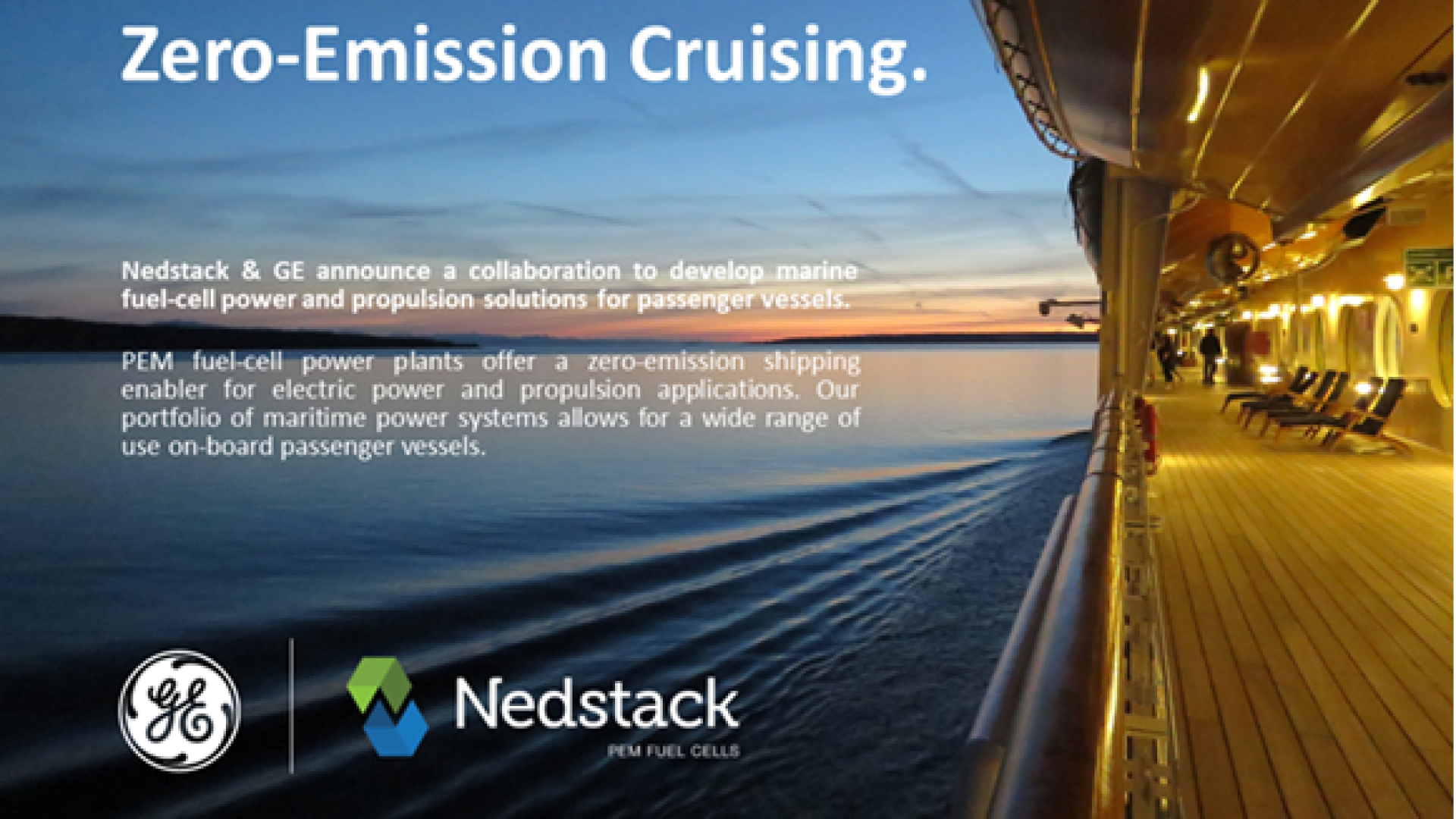March 21, 2019
- GE and Nedstack have entered into a partnership to develop hydrogen fuel cell power systems for cruise vessels
- Fuel Cell power systems eliminate vessel exhaust gases and by extension prevent harmful pollutants ending up in our atmosphere, our ecosystem and in vulnerable port communities
- PEM fuel cells only produce water, heat and electricity – making them an ideal solution for zero-emission cruise ships
- GE’s variable speed drive technology manages power generated to supply electricity to propulsion and onboard systems, as well extending fuel cell life
Paris – 21 March 2019 – GE’s Power Conversion business and Nedstack, a leading fuel cell manufacturer, are collaborating on developing hydrogen fuel cell systems for powering zero-emission cruise vessels.
This partnership brings together GE’s recognized expertise in cruise electrical power and propulsion solutions plus system integration capability, with Nedstack’s extensive experience in megawatt-scale hydrogen fuel cell technology. The result will be highly efficient fuel cell solutions that enable a zero-emission cruise industry.
Zero-emission cruising
The cruise industry shares a joint responsibility to eliminate the possible negative impacts it might have on port communities, the health of passengers and staff, and on the environment as a whole. Responsible zero-emission shipping is not only environmentally needed but will greatly contribute to the quality of the cruise experience itself.
Shipowners are already under pressure to comply with the reduced sulfur limit regulations coming into force next year. Both global International Maritime Organization (IMO) and regional regulations require marine vessels to reduce emissions or eliminate them altogether.
“Existing clean power solutions are focused on reducing emissions. Eliminating emissions altogether demands a paradigm shift,” Arnoud van de Bree, CEO of Nedstack says. “Hence why GE and Nedstack have been working extensively on the ‘marinization’ of fuel cell technology to create a total zero-emission alternative that truly meets the needs of tomorrow’s cruise industry.”
“We’re proud to be working with Nedstack on what we believe will be a game changer for the cruise industry,” said Ed Torres, CEO of Marine and O&G, GE’s Power Conversion business. “This partnership brings together a rich pool of expertise that’s spearheading much needed innovation. Given the marine transport and shipping sector’s changing regulatory landscape, this innovation could not be more timely.”
Maritime fuel cell applications
GE and Nedstack envisage using this technology on passenger ships, replacing traditional diesel engines with fuel cells, and heavy fuel oil (HFO) with hydrogen.
So far, Nedstack and GE have designed the concept for a two megawatt hydrogen fuel cell power plant on an expedition vessel. The review result has been highly positive and plausible. The ultimate goal is a truly zero-emission system that will enable the world’s first sustainable, clean cruise ships.
The advantage of GE’s hybrid electric drive system
GE’s variable speed electrical drive system is a crucial part of the system that optimizes control and efficiency by directing and managing the electricity produced by the hydrogen fuel cells.
Frequently switching fuel cells on and off reduces their life expectancy – and this is a significant issue for vessels. To give some perspective, while a car’s fuel cell is expected to operate for 7,000 hours, for a ship it needs to go over 20,000 hours. Machine longevity is essential. To overcome this, GE’s variable drive, fuel cell system architecture and dedicated PMS are engineered to limit the switch on-and-off frequency of the fuel cells when sailing or in port. Indeed, optimizing the system and extending the fuel cells’ lifespan is key to coping with the five-year dry dock intervals that cruise ships demand.
Nedstack and GE have designed a concept for a multi-megawatt hydrogen power plant for passenger vessels. The built-in redundancy and its scalability are promising.
“Ships are increasingly being required to shut down their engines in port. We’ve seen this in California, for example, and China has introduced an emission control area in the Yangtse delta. However, the trend is shifting from emissions reduction to total elimination. Achieving this will take deep expertise and innovation – and that’s precisely what this collaboration between GE and Nedstack will deliver,” says Azeez Mohammed, President and CEO, GE’s Power Conversion business.
About GE
GE (NYSE:GE) drives the world forward by tackling its biggest challenges: Energy, health, transportation—the essentials of modern life. By combining world-class engineering with software and analytics, GE helps the world work more efficiently, reliably, and safely. For more than 125 years, GE has invented the future of industry, and today it leads new paradigms in additive manufacturing, materials science, and data analytics. GE people are global, diverse and dedicated, operating with the highest integrity and passion to fulfill GE’s mission and deliver for our customers. www.ge.com
About GE Power
GE Power is a world energy leader providing equipment, solutions and services across the energy value chain from generation to consumption. Operating in more than 180 countries, our technology produces a third of the world’s electricity, equips 90 percent of power transmission utilities worldwide, and our software manages more than forty percent of the world’s energy. Through relentless innovation and continuous partnership with our customers, we are developing the energy technologies of the future and improving the power networks we depend on today. For more information please visit www.ge.com/power, and follow GE Power on Twitter and on LinkedIn.
For general press enquiries, please contact us here.

